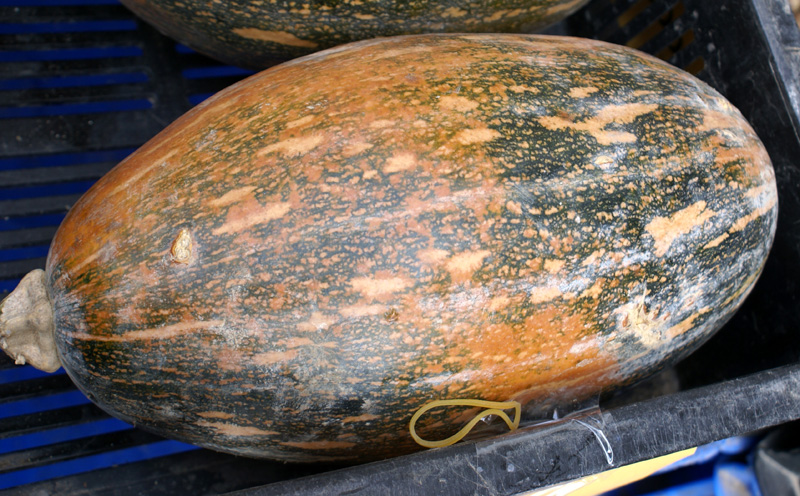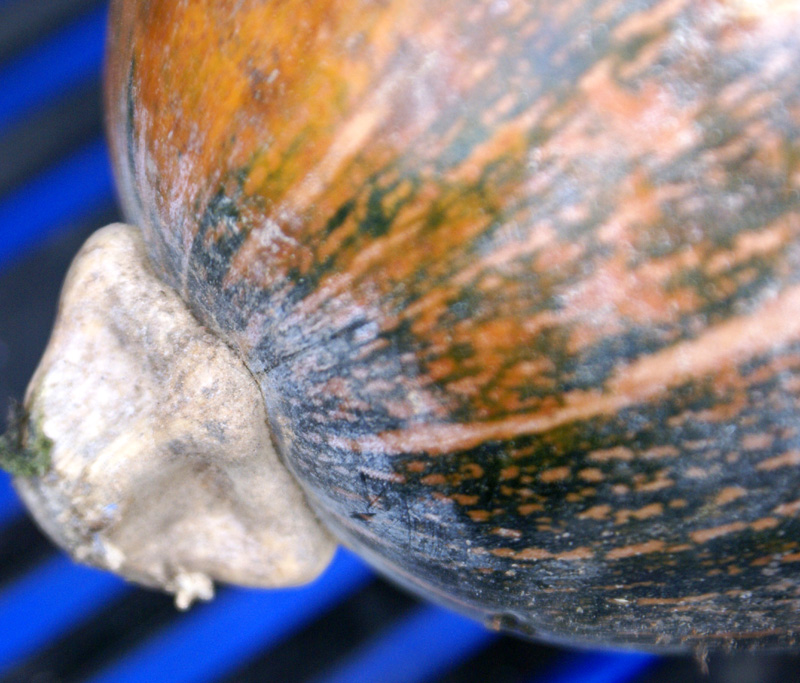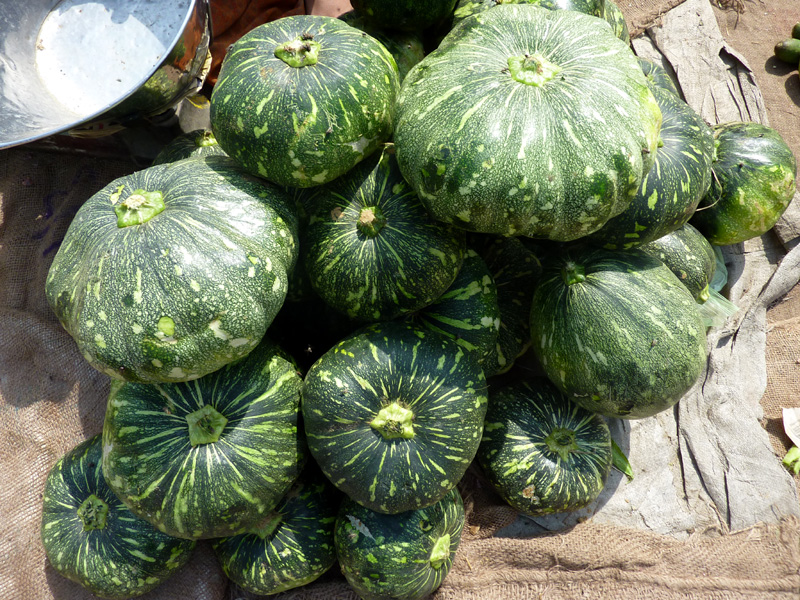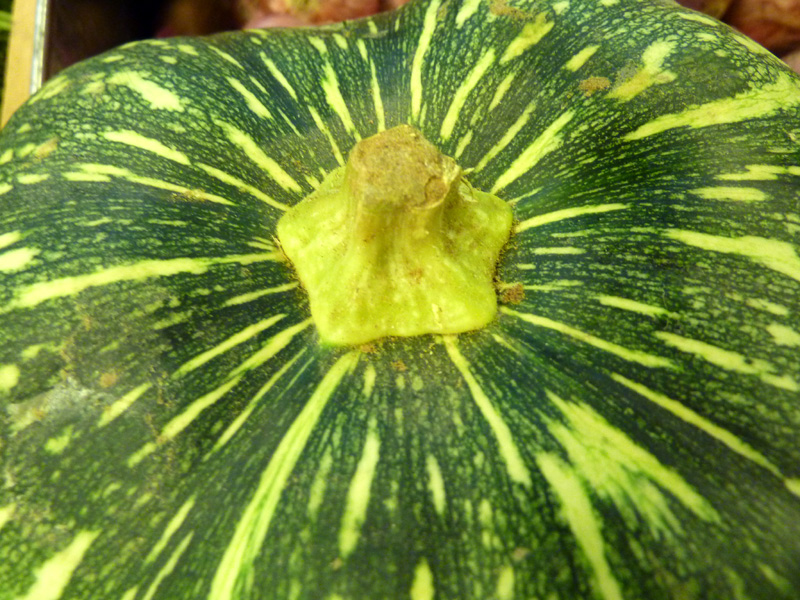Elusive Petha and Kaddu in India: thanks Ushadi for initiating my fresh visit to Sabzi mandi
1,545 views
Skip to first unread message
Gurcharan Singh
Apr 6, 2012, 2:48:04 AM4/6/12
to indian...@googlegroups.com
Having seen so many cultivars of Cucurbita maxima, C. moschata and C. pepo in California, and common names pumpkin, squash and gourd being so interchangeably used for any of these, I found the same confusion regarding Indian names Petha, kaddu and others being used in local markets.
For one I am happy that the key based on the tip of fruiting pedicel is very satisfactory in differentiating the fruiting specimens, although leaves and flowers may not be that reliable. For example in most sample Cucurbita moschata calyx lobes are foliaceous in specimens that I have seen in India, they are rarely so in most cultivars in USA.
Yesterday I uploaded photographs of Cucurbita moschata from India sold as Kaddu, whose plants were earlier uploaded by Balkar i as Cucurbita pepo but it turned out to be C. moschata
The comments yesterday by Ushadi about Kaddu fruits uploaded by me prompted me to make a revisit to the Keshavpur Sabzi mandi in our neinghbourhood (a big mandi in West Delhi) today morning. Luckily I could locate all the three types of so called petha in the market. One is very distinct especially when you attach Agra before it, the Ash gourd or white pumpkin, commonly used for making sweet.
The other two though quite distinct seemed to be more confusing to the sellers. More than ninety percent sellers called them petha or kaddu, and one being the younger stage and other the ripe stage of fruit, but finally one person knew them well: one which can last for more than a month (Cucurbita moschata), and another which has to be consumed within few days (Cucurbita pepo)
Cucurbita moschata: Halwa kaddu, kashi phal, mitha kadu, petha-The fruit is generally large, reaching 50 cm in length, nearly oblong, sking turning yellowish brown when mature, typical C. moschata constricted pad below fruit, flesh yellow. This plant was uploaded by me yesterday. Cooked as vegetable but with slightly sweeter taste, more commonly made into halwa. I had uploaded this yesterday. I am doing it again for comparison. Fruit purchased can be kept for more than a month without getting spoilt.
Cucurbita pepo: Gol kaddu, safed kaddu, Villaiti kadu, petha, Kadddu pumpkin: The fruit is some what depressed to nearly rounded, 20-30 cm across, pedicel tip with closely attached proecting finger, colour green with yellowish patches, flesh is pale yellowish white or greenish white. Commonly cooked as vegetable. The fruit generally plucked when not fully ripe does not last long.
I am still looking for another Kaddu from India the Red gourd, mitha kaddu, Sita Phal but as Cucurbita maxima and not C. moschata. I hope some one will upload from India in this episode.
Benincasa-hispida-Keshav-pur-Delhi-1
Cucurbita-moschata-halwa Kadu-Kashi phal-Vikas-puri-DSC01845-Delhi-1
Cucurbita-moschata-halwa Kadu-Kashi phal-Vikas-puri-DSC01846-Delhi-4
Cucurbita-pepo-Safed kaddu-Petha-Keshav-pur-Delhi-1
Cucurbita-pepo-Safed kadu-petha-Keshav-pur-Delhi-2
Gurcharan Singh
ushadi Micromini
Apr 6, 2012, 4:33:04 AM4/6/12
to Gurcharan Singh, indian...@googlegroups.com
Gurcharanji:
Thank you...
now I know the source of all the confusing names ... at least in the all the gourds and melons the world over...
with so many cultivars I think now that you have made the distinction so clear to understand, May be when I have a chance... I'll attempt make a poster of your pictures with the proper names below each one...of cultivars of Cucurbita maxima, C. moschata and C. pepo and the kaddus ...
Usha di--
Usha di
===========
Thank you...
now I know the source of all the confusing names ... at least in the all the gourds and melons the world over...
with so many cultivars I think now that you have made the distinction so clear to understand, May be when I have a chance... I'll attempt make a poster of your pictures with the proper names below each one...of cultivars of Cucurbita maxima, C. moschata and C. pepo and the kaddus ...
Usha di
Usha di
===========
surajit koley
Apr 6, 2012, 2:26:05 PM4/6/12
to indian...@googlegroups.com
Sir,
Thank you very much for this informative post. But, i have a question - why C. pepo is called 'safed kadu'? Is it white inside?
I have just posted one, thinking it a C. maxima, but my species could well be C. pepo. The inside of my gourd (my post) is yellow.
Thank you & Regards,
Surajit Koley
surajit koley
Apr 6, 2012, 2:28:50 PM4/6/12
to indian...@googlegroups.com
Sorry Sir, the link of my post is - https://groups.google.com/forum/?fromgroups#!topic/indiantreepix/3UAxLsJ8hKA
Gurcharan Singh
Apr 6, 2012, 10:42:39 PM4/6/12
to surajit koley, indian...@googlegroups.com
Surajit ji
Dr. Gurcharan Singh
Retired Associate Professor
SGTB Khalsa College, University of Delhi, Delhi-110007
Res: 932 Anand Kunj, Vikas Puri, New Delhi-110018.
Phone: 011-25518297 Mob: 9810359089
In Cucurbita pepo commonly used as cooked vegetable uploaded by me has much lighter flesh almost creamish white to greenish white and not sweeter to taste. Commonly also known as kumra.
Your above plant is neither C. maxima nor C. pepo. It is C. moschata. Please note foliaceous calyx lobes and clear constricted pad at the tip of the pedicel. Both C. maxima and C. moschata I hope have orange yellow flesh, cooked also as vegetable, but relished as halwa, and more appropriately mitha kumra. In fact C. maxima and C. moschata have same local names.
Perhaps the confusion is deep rooted (not fault of cucurbits, which are quite distinct). Last week I bought petha from one store here. Thinking it to be slightly unripe (being lighter creamish colour) and less is quantity, I bought more from another shop which had softer orange-yellow flesh, and cooked latter the same day. Now I realize that first was C. pepo and second C. moschata.
Retired Associate Professor
SGTB Khalsa College, University of Delhi, Delhi-110007
Res: 932 Anand Kunj, Vikas Puri, New Delhi-110018.
Phone: 011-25518297 Mob: 9810359089
surajit koley
Apr 7, 2012, 1:00:06 PM4/7/12
to Gurcharan Singh, indian...@googlegroups.com
Sir,
Thank you very much for these identifying keys to the three Cucurbita species.
Specially C. moschata & C. maxima were very confusing to me. More so because, according to 'Plant Groups', Gourd = C. maxima = C. moschata ! Now i know what to look for when i see another KUMRA in a field.
Regards,
Surajit Koley
Reply all
Reply to author
Forward
0 new messages





